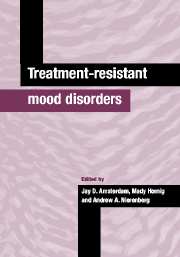Book contents
- Frontmatter
- Contents
- List of contributors
- Preface
- Part I The clinical problem
- 1 The characterization and definition of treatment-resistant mood disorders
- 2 Overview of treatment-resistant depression and its management
- Part II Biological basis
- Part III Treatment approaches
- Part IV Special patient populations
- Part V Economic and ethical issues
- Index
- Plate Section
1 - The characterization and definition of treatment-resistant mood disorders
from Part I - The clinical problem
Published online by Cambridge University Press: 25 March 2010
- Frontmatter
- Contents
- List of contributors
- Preface
- Part I The clinical problem
- 1 The characterization and definition of treatment-resistant mood disorders
- 2 Overview of treatment-resistant depression and its management
- Part II Biological basis
- Part III Treatment approaches
- Part IV Special patient populations
- Part V Economic and ethical issues
- Index
- Plate Section
Summary
Introduction
Despite rapid development in the therapeutic management of mood disorders, with the introduction of new classes of antidepressants and mood stabilizers since the 1980s, in clinical practice the problem of treatment resistance continues to occupy a considerable amount of the physician's time. Resistance to treatment is observed across the various forms of mood disorders, but has been mainly described for unipolar depression and bipolar affective disorder.
The importance of the problem is underlined by the existence of the many treatment algorithms and strategies proposed for treatment-resistant depression (TRD). Numerous outcome studies have demonstrated that approximately one-third of patients treated for major depression do not respond satisfactorily to the first round of antidepressant pharmacotherapy. Furthermore, follow-up observations reveal that a considerable number of patients have a poor prognosis, with as many as 20% remaining unwell 2 years after the onset of the illness (Paykel, 1994). Even after multiple interventions, up to 10% of patients remain depressed (Nierenberg & Amsterdam, 1990). A poor outcome in 17–21% of unipolar patients at 2 years and 8–13% at 5 years was also noted by the National Institute of Mental Health (NIMH) study of the psychobiology of depression (Winokur et al., 1993). It is estimated that 20% of patients with bipolar affective disorder remain ill for at least one year (Keller et al., 1986b) and up to 10% for 5 years (Coryell et al., 1989). It is difficult, however, to evaluate the true levels of resistance for different mood disorders from these figures (i.e., treatment resistance in unipolar and bipolar affective disorders).
Keywords
- Type
- Chapter
- Information
- Treatment-Resistant Mood Disorders , pp. 3 - 29Publisher: Cambridge University PressPrint publication year: 2001
- 11
- Cited by



